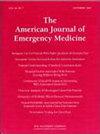Emergency medicine updates: Cardiac arrest medications
IF 2.7
3区 医学
Q1 EMERGENCY MEDICINE
引用次数: 0
Abstract
Introduction
Cardiac arrest is a serious condition frequently managed in the emergency department (ED). Medications are a component of cardiac arrest management.
Objective
This paper evaluates key evidence-based updates concerning medications used for patients in cardiac arrest.
Discussion
Several medications have been evaluated for use in cardiac arrest. Routes of administration may include intravenous (IV) and intraosseous (IO). IV administration is recommended, though if an attempt at IV access is unsuccessful, IO access can be utilized. Epinephrine is a core component of guidelines, which recommend 1 mg in those with shockable rhythms if initial CPR and defibrillation are unsuccessful, while in nonshockable rhythms, guidelines recommend that epinephrine 1 mg be administered as soon as feasible. While epinephrine may improve rates of ROSC, it is not associated with improved survival with a favorable neurologic outcome. Evidence suggests the combination of vasopressin, steroids, and epinephrine may improve ROSC among those with in-hospital cardiac arrest, but there is no improvement in survival to discharge and survival with a favorable neurologic outcome. Antiarrhythmics (e.g., amiodarone, lidocaine, procainamide) likely do not improve short-term or long-term survival or neurologic outcomes, though guidelines state that amiodarone may be used in those with cardiac arrest and refractory pulseless ventricular tachycardia (pVT)/ventricular fibrillation (VF). Calcium and sodium bicarbonate should not be routinely administered in those with cardiac arrest. Beta-blockers may be considered in those with shock-resistant pVT/VF.
Conclusions
An understanding of literature updates concerning medication use in cardiac can improve the ED care of these patients.
急诊医学更新:心脏骤停药物
心脏骤停是急诊科(ED)经常处理的一种严重疾病。药物治疗是心脏骤停治疗的一个组成部分。目的评价心脏骤停患者用药的循证最新进展。几种药物已被评估用于心脏骤停。给药途径包括静脉注射(IV)和骨内注射(IO)。建议静脉注射,但如果尝试静脉注射不成功,可以利用静脉注射。肾上腺素是指南的核心组成部分,如果最初的心肺复苏术和除颤不成功,指南建议对有震荡性心律的患者给予1毫克肾上腺素,而对于无震荡性心律的患者,指南建议在可行的情况下尽快给予1毫克肾上腺素。虽然肾上腺素可以提高ROSC的发生率,但它与改善生存率和良好的神经预后无关。有证据表明,抗利尿激素、类固醇和肾上腺素联合应用可能改善住院心脏骤停患者的ROSC,但对出院生存和神经系统预后良好的生存没有改善。抗心律失常药物(如胺碘酮、利多卡因、普鲁卡因胺)可能不会改善短期或长期生存或神经系统预后,尽管指南指出胺碘酮可用于心脏骤停和难治性无脉性室性心动过速(pVT)/心室颤动(VF)。心脏骤停患者不应常规使用碳酸钙和碳酸氢钠。抗冲击pVT/VF患者可考虑使用-受体阻滞剂。结论了解心内科用药方面的最新文献,有助于提高急诊科患者的护理水平。
本文章由计算机程序翻译,如有差异,请以英文原文为准。
求助全文
约1分钟内获得全文
求助全文
来源期刊
CiteScore
6.00
自引率
5.60%
发文量
730
审稿时长
42 days
期刊介绍:
A distinctive blend of practicality and scholarliness makes the American Journal of Emergency Medicine a key source for information on emergency medical care. Covering all activities concerned with emergency medicine, it is the journal to turn to for information to help increase the ability to understand, recognize and treat emergency conditions. Issues contain clinical articles, case reports, review articles, editorials, international notes, book reviews and more.

 求助内容:
求助内容: 应助结果提醒方式:
应助结果提醒方式:


